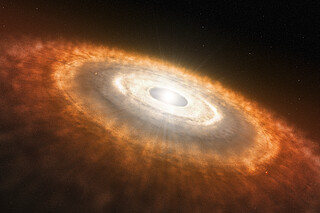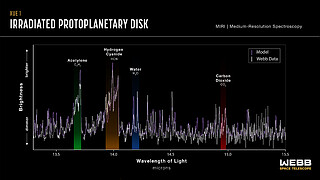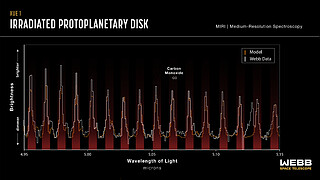weic2329 — Science Release
Webb study reveals rocky planets can form in extreme environments
30 November 2023
An international team of astronomers have used the NASA/ESA/CSA James Webb Space Telescope to provide the first observation of water and other molecules in the inner, rocky-planet-forming regions of a disc in one of the most extreme environments in our Galaxy. These results suggest that the conditions for rocky-planet formation, typically found in the discs of low-mass star-forming regions, can also occur in massive-star-forming regions and possibly a broader range of environments.
These are the first results from the eXtreme UV Environments (XUE) James Webb Space Telescope programme, that focuses on the characterisation of planet-forming disc in massive-star-forming regions. These regions are likely representative of the environment in which most planetary systems formed. Understanding the impact of environment on planet formation is important for scientists to gain insights into the diversity of the observed exoplanet populations.
The XUE programme targets a total of 15 discs in three areas of the Lobster Nebula (also known as NGC 6357), a large emission nebula roughly 5500 light-years away from Earth in the constellation Scorpius. The Lobster Nebula is one of the youngest and closest massive star formation complexes, and is host to some of the most massive stars in our Galaxy. Massive stars are hotter, and therefore emit more ultraviolet (UV) radiation. This can disperse the gas, making the expected disc lifetime as short as a million years. Thanks to Webb, astronomers can now study the effect of UV radiation on the inner rocky-planet-forming regions of protoplanetary discs around stars like our Sun.
“Webb is the only telescope with the spatial resolution and sensitivity to study planet-forming discs in massive-star-forming regions,” said team lead María Claudia Ramírez-Tannus of the Max Planck Institute for Astronomy in Germany.
Astronomers aim to characterise the physical properties and chemical composition of the rocky-planet-forming regions of discs in the Lobster Nebula using Webb’s Medium Resolution Spectrometer (MRS) of the Mid-InfraRed Instrument (MIRI). This first result focuses on the protoplanetary disc termed XUE 1, which is located in the star cluster Pismis 24.
“Only the MIRI wavelength range and spectral resolution allow us to probe the molecular inventory and physical conditions of the warm gas and dust where rocky planets form,” said team member Arjan Bik of Stockholm University in Sweden.
Because of its location near several massive stars in NGC6357, scientists expect XUE 1 to have been constantly exposed to a high ultraviolet radiation field throughout its life. However, in this extreme environment the team still detected a range of molecules that are the building blocks of rocky planets.
“We find that the inner disk around XUE 1 is remarkably similar to those in nearby star-forming regions,” said team member Rens Waters of Radboud University in the Netherlands. “We’ve detected water and other molecules like carbon monoxide, carbon dioxide, hydrogen cyanide and acetylene. However, the emission found was weaker than some models predicted. This might imply a small outer disc radius.”
“We were surprised and excited because this is the first time that these molecules have been detected under such extreme conditions,” added Lars Cuijpers of Radboud University. The team also found small, partially crystalline silicate dust at the disc’s surface. This is considered to be the building blocks of rocky planets.
These results are good news for rocky planet formation, as the science team finds that the conditions in the inner disc resemble those found in the well-studied disks located in nearby star-forming regions, where only low-mass stars form. This suggests that rocky planets can form in a much broader range of environments than previously believed.
The team notes that the remaining observations from the XUE programme are crucial to establishing the commonality of these conditions.
“XUE1 shows us that the conditions to form rocky planets are there, so the next step is to check how common that is,” says Ramírez-Tannus. “We will observe other discs in the same region to determine the frequency with which these conditions can be observed.”
These results have been published in The Astrophysical Journal.
More information
Webb is the largest, most powerful telescope ever launched into space. Under an international collaboration agreement, ESA provided the telescope’s launch service, using the Ariane 5 launch vehicle. Working with partners, ESA was responsible for the development and qualification of Ariane 5 adaptations for the Webb mission and for the procurement of the launch service by Arianespace. ESA also provided the workhorse spectrograph NIRSpec and 50% of the mid-infrared instrument MIRI, which was designed and built by a consortium of nationally funded European Institutes (The MIRI European Consortium) in partnership with JPL and the University of Arizona.
Webb is an international partnership between NASA, ESA and the Canadian Space Agency (CSA).
Links
- ESA Webb Seeing Farther Interactive Brochure
- Release on STScI website
- Release on ESA website
- Release on NASA website
- Science paper
Contacts
María Claudia Ramírez-Tannus
Max Planck Institute for Astronomy
Email: [email protected]
Arjan Bik
Stockholm University
Email: [email protected]
Bethany Downer
ESA/Webb Chief Science Communications Officer
Email: [email protected]
Ninja Menning
ESA Newsroom and Media Relations Office
Email: [email protected]
About the Release
| Release No.: | weic2329 | |
|---|---|---|





